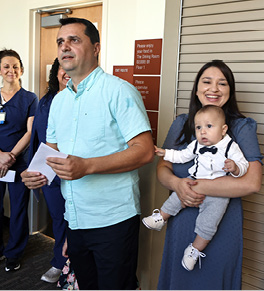Anesthesia and Perioperative Care Services
The board-certified anesthesiologists at UCI Health oversee anesthesia care during all surgical procedures. They combine state-of-the-art technology with compassion and concern for your comfort.
We provide:
- Comprehensive pre-operative evaluation before any elective operation
- Constant monitoring and modification of anesthesia to ensure maximum safety and comfort during the operation
- Follow-up care and pain management during your recovery
Anesthesia Types
Before surgery, each patient is individually assessed by a UCI Health anesthesiologist. After this evaluation, a customized plan is formulated based on the individual patient's physical status, overall health and other factors.
Technological advancements have made it possible to customize medications to meet each patient's needs.
There are four main types of anesthesia:
- Local anesthesia
A small amount of anesthetic is applied or injected to block pain in a localized area, such as biopsies and minor surgery.
- Regional anesthesia
Regional anesthesia blocks pain in larger areas of the body, such as the back, without causing unconsciousness. This is accomplished by injecting a small amount of anesthetic near a cluster of nerves that can numb the region of the body undergoing surgery. This form of anesthesia includes spinal blocks and epidurals.
- Conscious or intravenous sedation
A combination of medications are used to relax you and block pain. You stay awake but may not remember the procedure afterward. This type of anesthesia may be used for minor surgical and diagnostic procedures, such as repair of a fractured bone, minor skin surgery and plastic or reconstructive surgery.
- General anesthesia
General anesthesia affects the whole body, putting you to sleep, blocking pain and relaxing your muscles. General anesthetic drugs may include gases or vapors inhaled through a mask or tube. Others are administered through a vein.
Surgical Monitoring
Our anesthesiologists use state-of-the-art equipment to monitor patients’ breathing, heart rhythms and blood pressure, as well as brain and kidney functions during surgery.
We use the Bispectral Index (BIS), a device that checks the consciousness level of patients on a second-by-second basis. Considered one of the most important breakthroughs in anesthesiology in the last decade, BIS makes it possible to administer 30 percent less anesthetic than before, while ensuring that the patient remains in a state of deep sleep.
As a result, physicians are able to "fast track" patients. The less anesthesia patients have, the faster they can recover. Individuals undergoing cardiac surgery, for example, can have their breathing tubes removed several hours earlier because they've had less anesthesia. The result: BIS patients are discharged sooner than in the past, often as much as 19 percent sooner.
This equipment also guards against what doctors call "patient awareness" during surgery by continuously monitoring the depth of anesthesia. With precision, the BIS monitor measures the effectiveness of anesthesia on a patient, making it possible for the anesthesiologist to respond quickly and appropriately should the patient's status change.
About Us
To qualify for their important role in the surgical suite, anesthesiologists must have an excellent understanding of cardiology, critical care medicine, internal medicine, pharmacology and surgery.
At UCI Health, many of our board-certified anesthesiologists have taken an additional one to two years of training in another subspecialty, such as neurology, pediatrics, neonatal medicine, cardiology and regional anesthesiology.
This added level of expertise and experience reflects our status as a nationally recognized university hospital.
Our team also includes certified registered nurse anesthetists (CRNA), licensed, nationally certified professionals who are trained to take care of a patient's anesthesia needs before, during and after surgery, including the delivery of a baby.









